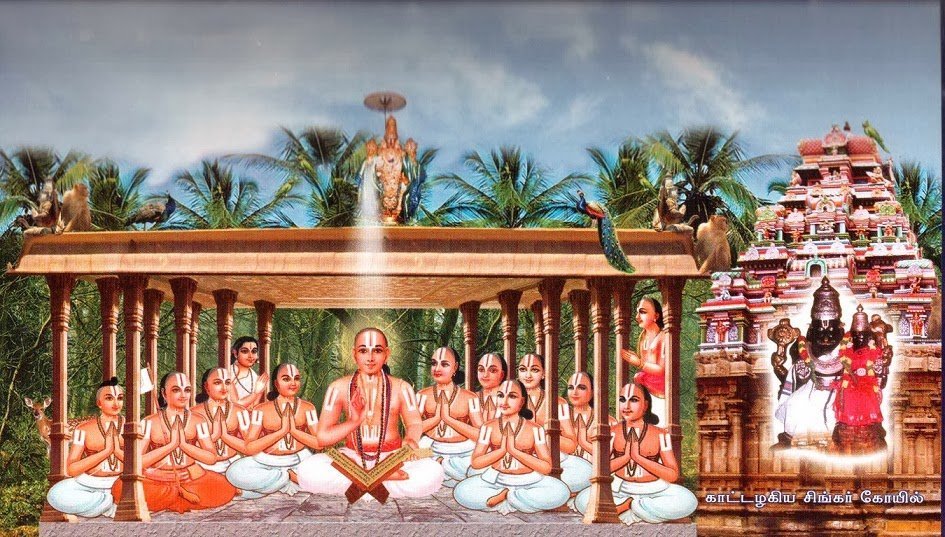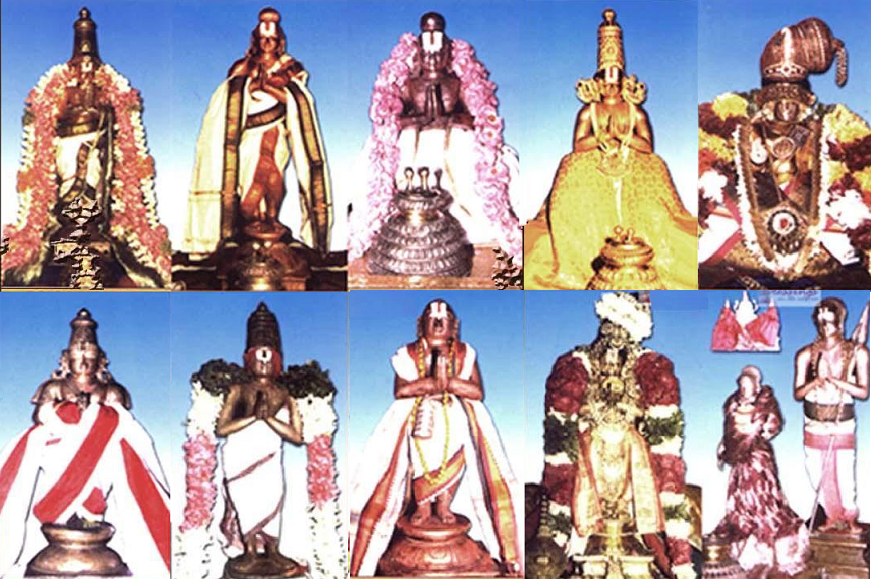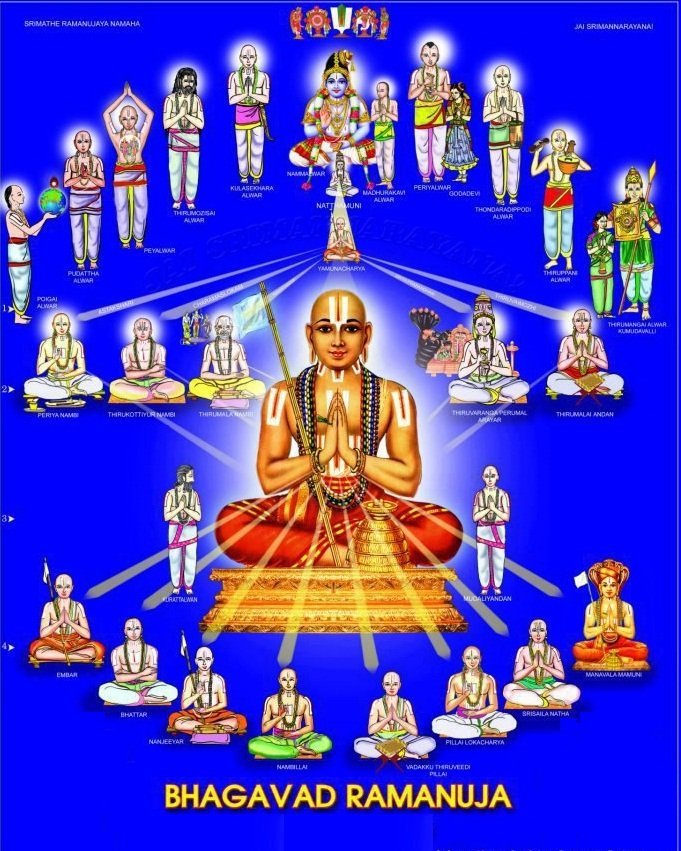SrI: SrImathE SatakOpAya nama: SrImathE rAmAnujAya nama: SrImadh varavaramunayE nama:
thirumanthram is the essence of the whole of vEdham. The three words in thirumanthram reveal the three principles (ananyArha SEshathvam – being subservient to bhagavAn only, ananya SaraNathvam – accepting bhagavAn as the only refuge, ananya bhOgyathvam – accepting bhagavAn as the only enjoyable aspect and is also explained as being an object of pleasure for bhagavAn only). These 3 principles are common for all jIvAthmAs. Even though all jIvAthmAs have the necessary qualification to be in paramapadham (which is fully pure) which is the abode of nithyasUris who are explained in yajur vEdham achchidhram as “yathra rshaya: prathama jAyE purANA:” (The residents of paramapadham who are foremost and ancient), where everyone’s knowledge is fully blossomed/expanded, where there is eternal bliss which is derived out of constant engagement in bhagavAn‘s names, forms, qualities, etc., as said in mANdukya upanishath 2.21″anAdhi mAyayA suptha:” (being covered by ignorance since time immemorial) and “thila thailavath dhAru vahnivath” (remaining inseparable from matter as oil inside sesame seed and fire inside firewood), jIvAthmAs (bound souls) are covered with the beginningless mAyA (which is controlled by bhagavAn) that covers the knowledge and have beginningless ignorance which leads to accumulated and endless karma (virtues and vices) which leads to countless births in sura (heavenly), nara (human), thiryak (animals) and sthAvara (plants) as said in thiruvAimozhi 2.6.8 “mARi mARip pala piRappum piRandhu” (taking birth continuously in various species). In every birth, they go through many pitfalls such as dhEhAthmAbimAnam (considering body as the self), svAthanthriyam (considering oneself as independent), anya SEshathvam (serving anyone other than bhagavAn) and engage in efforts and results to fit such qualities. Such jIvAthmAs are with the vow to leave emperumAn in whatever possible manner as said in thiruviruththam 95 “yAdhAnum paRRi nIngum virdhaththai” (the vow of leaving bhagavAn by holding on to anything in the materialistic realm), being greatly averse to bhagavAn who is the ultimate master and the best goal and means for jIvAthmAs. As a result, the jIvAthmA goes through the seven stages namely garbha (being in the womb), janma (taking birth), bAlya (being a child who cannot take care of himself), yauvana (youth which is fully focussed on sense enjoyment), vArdhaka (old age), maraNa (death) and naraka (life in hellish planets) which lead to eternal and endless sorrows. Among those suffering souls, a few accept the grace of bhagavAn which is given at the time of birth, which subdues the rajO (passion) and thamO (ignorance) guNams (qualities) and raises sathva guNam (quality of goodness) and develops the desire for mOksham (liberation).
- When one desires for mOksham, one needs to understand thathvam (the nature of jIvAthmA being subservient to bhagavAn), hitham (the means) and purushArtham (goal) to be uplifted.
- When trying to understand these 3 principles through SAsthram (which is the primary source for this knowledge), vEdham which is the chief among SAsthrams is pursued. But, as mentioned in yajur vEdham 1.44 “ananthA vai vEdhA:“, vEdham is endless. And to determine any principle from vEdham, one has to use certain methods such as “sarva SAkA prathyaya nyAyam” (determining the principle by going through various sections of vEdham to ensure perfect understanding) etc. All these are too difficult for people of limited intelligence.
- Considering that understanding the true principles from vEdham is too difficult, the next source is to go to the rishis (sages) such as vyAsa et al who have mastered the vEdham out of their own great efforts and compiled smruthi, ithihAsas and purANas. But in these, only capable persons will be able to distinguish between the essence and extraneous aspects.
- Considering the difficulty in that, one can look up to bhagavAn who most mercifully accepts the role of an AchAryan and reveals the rahasya thrayam (thirumanthram, dhvayam, charama slOkam) for the benefit of all jIvAthmAs. But those are too brief and the great meanings that are present in them are difficult to grasp for everyone.
- AzhwArs (paraAnkuSa, parakAla et al) who were divinely blessed with blemishless knowledge and devotion by bhagavAn himself out of his causeless mercy, understood the essence of the whole vEdham and revealed the same in the most precise manner through dhivya prabhandhams which are hailed as dhrAvida vEdham and its angam (part), upAngam (ancillary-part). Yet, people with limited intelligence could not fully understand the real purport of dhivya prabhandhams.
- Seeing that even the ones who have taste for bhagavath vishayam are missing out on the essence due to their limited intelligence, AchAryas starting with SrIman nAthamunigaL who were divinely blessed by the causeless mercy of AzhwArs, who firmly established the sath sampradhAyam, who were expert in all of SAsthram and who were most compassionate, understood the essence of vEdham etc and explained the same in the most precise manner so that even people of less intelligence can understand the same. They also documented the sath sampradhAyam principles in various granthams.
- Following in their foot steps, piLLai lOkAchAryar out of great compassion towards the suffering souls who are missing out on the wonderful opportunity to serve bhagavAn directly and eternally, for the benefit of such souls, compiled many prabhandhams. These principles were previously transmitted through the AchArya paramparai in an oral tradition. pUrvAchAryas, seeing the most valuable nature of the principles, taught this in a confidential manner to Sishyas. Seeing the most glorious nature of the principles, they did not reveal them in public. But, piLLai lOkAchAryar, observing the fate of the future generation who may miss out on these valuable principles, out of his great compassion and based on the desire/orders of bhagavAn himself through svapnam (dream), reveals the most important principles through this grantham named SrIvachana bhUshaNam.
Previously, pEraruLALap perumAL (kAnchIpuram varadharAjap perumAL), out of his causeless mercy, specially blessed a SrIvaishNava named nambi in the town named maNaRpAkkam. He explained some of the essential aspects of the sath sampradhAyam in the svapnam (dream) of maNaRpAkkaththu nambi and then instructs him “Now, you go and stay in between the two rivers (SrIrangam which is situated in between kAviri and koLLidam), I will reveal the same principles in full details”. nambi, following those instructions, arrives at SrIrangam, stays there worshipping periya perumAL and without revealing his identity, just remains there constantly meditating on the principles originally revealed by pEraruLALan.
 piLLai lOkAchAryar kAlakshEpa gOshti
piLLai lOkAchAryar kAlakshEpa gOshti
Once when he was alone at kAttazhagiya singar temple (a temple on the outskirts of SrIrangam), piLLai lOkAchAryar arrives there along with his Sishyas by the divine will of bhagavAn. Since the temple is remotely located with minimum disturbances, he starts explaining the rahasyArthams (confidential meanings) of our sath sampradhAyam to his disciples. maNaRpAkkathu nambi who hears them (from a place where the others cannot see him) and understands that they resemble the same meanings that were revealed by pEraruLALa perumAL, becomes ecstatic. He comes out from inside and falls at the lotus feet of piLLai lOkAchAryar and asks him “Are you him?” and piLLai responds “Yes, what should be done?”. nambi then explains that pEraruLALa perumAL explained the same principles first and directed him to SrIrangam to understand the same in great detail. piLLai lOkAchArar feeling elated, accepts nambi (as a Sishya) and nambi starts serving him and learning the principles in detail from him. Once emperumAn appears in the dream of nambi and instructs him to request piLLai lOkAchAryar to document these wonderful and most important principles in a prabhandham so that it is not forgotten over time. nambi goes to piLLai lOkAchAryar and reveals the desire of emperumAn and piLLai lOkAchAryar says “If that is his desire, I will do that” and compiled SrIvachana bhUshaNam – this incident is well known and well established.
Just like an ornament that has many rathnams (gems) is named rathna bhUshaNam, since this prabhandham is filled with the words/phrases of our pUrvAchArayas and brings about great radiance of knowledge to the ones who meditate on this prabhandham, it is named SrIvachana bhUshaNam.
 piLLai lOkAchAryar, mAmunigaL – SrIperumbUthUr
piLLai lOkAchAryar, mAmunigaL – SrIperumbUthUr
Thus ends the first part of most magnificent introduction section for SrIvachana bhUshaNam. This grantham is greatly glorified for presenting the most important principles of our sath sampradhAyam in the simplest possible way. With mAmunigaL‘s beautiful and precise commentary, this is a great treasure for us to cherish. It is most beneficial if this grantham is heard under an AchArya to understand the principles fully. Let us bow down at the lotus feet of these great AchAryas and be blessed.
adiyen sarathy ramanuja dasan
archived in https://granthams.koyil.org/
pramEyam (goal) – https://koyil.org
pramANam (scriptures) – https://granthams.koyil.org
pramAthA (preceptors) – https://acharyas.koyil.org
SrIvaishNava Education/Kids Portal – https://pillai.koyil.org

